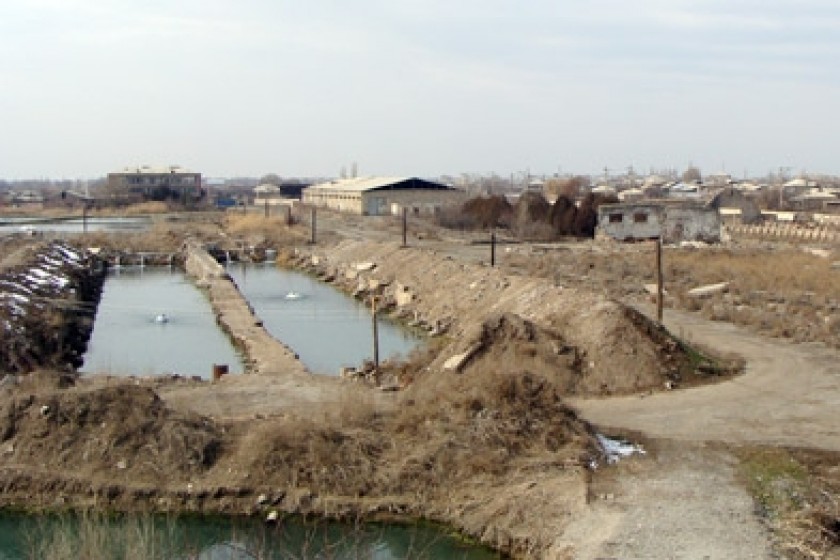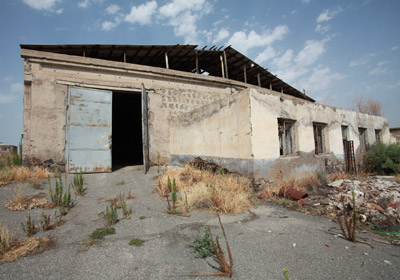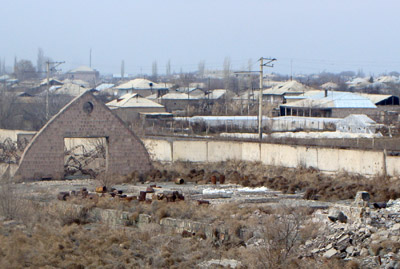
Toxic Mix: Pesticides and Fish Farms
Is DDT leaking from Jrarat pesticide warehouse?
We first got a whiff of the pesticides from the road while we looked over the expanse before us.
Leaving the village of Jrarat, in Armavir Marz, you'll gaze across the site where the former Soviet pesticide storage facility was located. It was the largest of its kind. This was where trains unloaded the chemicals before distributing them to other warehouses.
Today, the place is in ruins. Sections of the old facility are scattered here and there. The site now houses a number of large fish breeding ponds.
Garik Hovhannisyan, Mayor of Jrarat, told us that little remains of the former facility. Some was pilfered by local residents and the rest sold off. The site is fenced off today.
Warehouse owner reluctant to talk
We were not allowed inside. We needed to get permission first from the owner – Jrarat resident Grigor Grigoryan.
He used to direct the facility in the Soviet period and was able to gain ownership when the Soviet Union collapsed. He now runs one of the largest fish farms in Armavir – Konstantine and Sisters.
According to Ministry of Nature Protection (MNP) records, the firm is the third largest consumer of water in Armavir.
Mr. Grigoryan wasn't around the day we visited. One of the employees took us to see his wife's brother Davit, who oversees the operation.
Davit called Mr. Grigoryan, asking if we could enter the site. Davit said the answer was no, and passed the phone to me. In an angry voice, Mr. Grigoryan advised me to write about other matters; for example, why gasoline and sugar had gone up in price.
I replied that our group simply wanted to see what pesticides were stored there and in what quantities. He said there was nothing to see; the place was in ruins. Mr. Grigoryan was quick to add that samples of the fish farm water and the fish themselves showed nothing out of the ordinary.
Why was he so reluctant to let us peek around? Did he have anything to hide? He claimed that there were no traces of the toxic pesticides in the fish ponds, but...
Traces of DDT found in soil
The Czech Arnika Association and the local NGO Armenian Women for Health and Healthy Environment (AWHHE) have uncovered old stores of expired pesticides in Armenia and DDT pollutants. Their investigations were part of the Poisons and Wastes project.
The largest concentrations are to be found in Jrarat.
"The most shattering of all our findings was the 50% DDT concentrations in samples taken from the Jrarat facility. There are hundreds of kilos of the stuff there. There are torn sacks of DDT scattered all throughout the ruined facility. Naturally, in this condition, the pesticide is easily spread about by the wind and rain. It leads to pollution of the local environment on a wide scale."
The above is the conclusion reached by Syuzanna Honsaykova at the Czech Chemical Technology Institute.
Tests have shown 647 grams of DDT in each kilo of pesticide from the sacks. That's to say, they were sacks originally containing pure DDT but that over time some of the pesticide has broken down, forming other potential carcinogens like DDD and DDE.
Even though the owner of the storage facility and fish farm told us that nothing was left inside, there were sacks and barrels of pesticides in one of the buildings. The roof had caved in, exposing some of the chemicals to the elements.
 There is a smaller warehouse out in back, but it's closed off and presents less of a danger in terms of the pesticides spreading. The other warehouses are all dilapidated.
There is a smaller warehouse out in back, but it's closed off and presents less of a danger in terms of the pesticides spreading. The other warehouses are all dilapidated.
Lilik Simonyan, who heads the Hygiene and Ecological Risks Division at the AWHHE, wonders why the storage facilities have collapsed. "It wasn't as if their contents were removed and the structures torn down. The collected pesticides remain underneath. You can spot the torn paper bags and the pesticides falling out."
One also sees pesticide barrels at the site. Most of the pesticides that have spilt out contain active DDT. Ms. Simonyan says the powder can quite easily be carried away on a hot windy day. Furthermore, since the site isn't covered the elements – wind, rain, snow – can easily spread the poisonous powders.
Tests of one kilogram of soil have shown 280 milligrams of DDT, DDD and DDE.
Are pesticides polluting nearby fish ponds?
 The surrounding soil has been polluted. Given that the nearby fish ponds are not cement lined, one can only assume that the toxins have leeched into the water and, by extension, the fish.
The surrounding soil has been polluted. Given that the nearby fish ponds are not cement lined, one can only assume that the toxins have leeched into the water and, by extension, the fish.
Most of the world banned the use of DDT as a pesticide in the 1970's.
Armenia is a signatory to the Stockholm Convention on Persistent Organic Pollutants, an international environmental treaty, signed in 2001 and effective from May 2004, which aims to eliminate or restrict the production and use of persistent organic pollutants (POPs).
Armenia has also supposedly drafted a program of potential "hot spots".
Government officials dismiss safety concerns
Anahit Aleksandryan, Head of the MNP's Division of Hazardous Substances and Waste Policy, never even mentioned Jrarat in her conversation with Hetq. "Nothing was discovered there because nothing was there. They said so." This was her rationale and reference to the Ministry of Agriculture. In effect, she was stating that the responsibility to uncover the danger rested with them.
Karine Yesayan, who heads the Department of Horticulture Development at the Ministry of Agriculture, says that they can't know the amounts of pesticides stored in warehouses in Armenia since no inventory has yet been taken.
"Yes, we have a serious problem that needs to be resolved by taking an inventory. Once we know the size of the problem, we might be able to present our findings to the government and look for potential donors, or if the soil has been polluted, how to restore it."
Ministry has no clue as to pesticide amounts
When I asked Ms. Yesayan who was supposed to have monitored pesticide stocks after the fall of the Soviet Union, and whether the new property owners had some legal obligations in this regard, she answered, "How should I know?"
The Ministry official then went on to say that the problem existed throughout all of the former Soviet countries and that, in comparison, Armenia had less to worry about.
Ms. Yesayan said that the Ministry would soon launch a pilot inventory program encompassing the ten largest communities in three Armenian marzes. $7,500 has been earmarked for the work.
Preliminary estimates place the amount of pesticides at 53-55 tons. Ms. Yesayan believes this figure should be tripled.
However, she claims that pesticide stocks in Armenia, except for the Jrarat facility, pose no serious risks.
When we asked if preventative measures were planned for Jrarat, the official assured us that the community was in no danger since the storage facility was quite some distance away from the nearest homes.
"There is no flow from there to the village and local residents can't access the site since it is well monitored."
"Some people just artificially raise the alarm"
When we pointed out that the site was right off to the side of the village and that the pesticides could easily be spread by wind or rain, Ms. Yesayan responded, "Whatever's inside the storehouse can't get out by wind or rain."
We then asked about the sacks of pesticides scattered outside.
She waved off any potential risks.
"None of those sacks are chlorine organic. People see some bags lying about but have no clue what's inside. All these civic groups know that monies are being allocated by international agencies to clean up the organic wastes and some just want to make some noise over nothing and get a piece of the pie."
Three other pesticide storage sites have been found in the communities of Masis, Etchmiadzin and Armavir. All of them are locked up and enclosed, and thus less dangerous.
Lilik Simonyan says her organization is constantly pressing for an inspection of these sites in addition to the better known Nubarashen toxic dump.
"We want to see the sites linked and a joint strategy devised to solve the problem. If the pesticides need to be transported away, let them do so. If they have to be neutralized on-site, that's what should be done. Just as long as they resolve the mess>"
No one can say for certain just how polluted are the fish farms and local environment that border the Jrarat pesticide facility.
Czech specialist have taken egg and other food samples for laboratory testing.
They will return to Armenia this month and publish their findings.
 Videos
Videos Photos
Photos




Write a comment